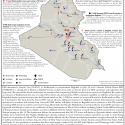 |
 |
Iraq Situation Report: July 19-25, 2016
Jul 25, 2016 - Emily Anagnostos


ISIS detonated a Suicide Vest (SVEST) in Kadhimiyah in northwestern Baghdad on July 24, and a Suicide Vehicle Borne-IED (SVBIED) at a checkpoint in Khalis, in Diyala Province, on July 25 in order to distract from anti-ISIS operations and undermine the Iraqi state. The spectacular attacks undermine the narrative that recapturing Fallujah would increase security for Baghdad. The attack at an entrance of Kadhimiyah, the seat of a major Shi’a shrine, also demonstrates ISIS’s continued capability to infiltrate secured areas of Baghdad, despite increased security after the Karrada attack on July 3. ISIS last carried out a successful attack in Kadhimiyah on May 11 at a checkpoint. The Iraqi Security Forces (ISF) cannot allocate additional manpower to Baghdad without detracting from ongoing operations in northern and western Iraq. Successful ISIS attacks will likely increase in Baghdad and its environs as the ISF contests remaining ISIS terrain in northern and western Iraq. Meanwhile, the Popular Mobilization inserted itself into slowed ISF operations in Qayyarah and Shirqat in order to set conditions for their participation in Mosul. Shi’a militias, including Sadrist Trend affiliated Saraya al-Salaam, Iranian-backed proxy militias, and those affiliated with the Islamic Supreme Council of Iraq (ISCI) moved forces towards Shirqat starting on July 19. The deployment follows the announcement that 560 U.S. forces will deploy to Qayyarah airbase, which Shi’a militias have condemned. The Popular Mobilization will also attempt to insert itself into northern operations in order to avoid being boxed out of operations in Mosul. The Coalition, Kurdish officials, and the Ninewa provincial government strongly advocated for a lack of militia involvement in northern Iraq out of fear of Shi’a-Sunni sectarian reprisals in terrain already contested between Sunni Arabs and Kurds. So far, operations in northern Iraq have been largely conducted by the ISF, tribal fighters, and Peshmerga with Coalition support. Its presence may also make it difficult to deconflict Coalition and militia operations.
Prime Minister Haidar al-Abadi accepted the resignation of seven ministers on July 19 and July 20, suggesting that PM Abadi will seek to restart the Cabinet reshuffle process. The seven ministers, all from the pan-Shi’a National Alliance, include the three Sadrist Trend-affiliated Ahrar ministers and two of the ISCI ministers, who offered their resignations to PM Abadi in March and April as a show of support for the Cabinet reshuffle. PM Abadi left the offers unanswered until now. The timing of PM Abadi’s acceptance of the resignations may suggest that he intends to reopen the Cabinet reshuffle process. He may also seek to circumvent attempts by political competitors, primarily the Reform Front, led by former PM Nouri al-Maliki, and Muqtada al-Sadr, to set the terms of the reshuffle that would suit their interests. PM Abadi will need to maneuver the reshuffle process in order to appease reformers such as Sadr while maintaining cohesion with all political parties – namely the Kurds – in the Council of Representatives (CoR). PM Abadi may not survive a second failed Cabinet reshuffle or a re-fracturing of the CoR. Meanwhile, Maliki is working behind the scenes to garner a political support base and convince other political forces to support him as a candidate for the premiership should the reshuffle fail.